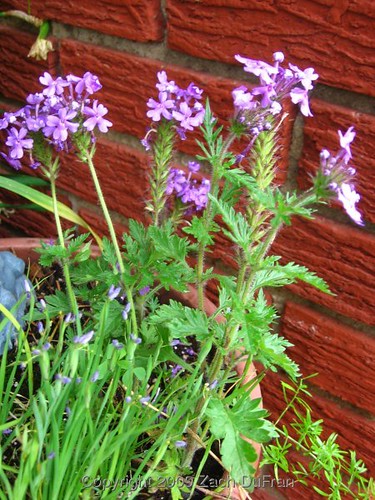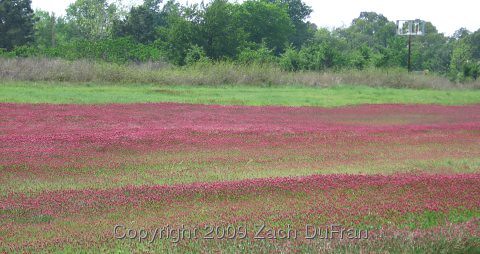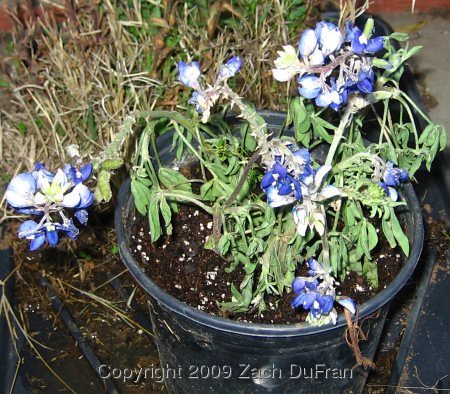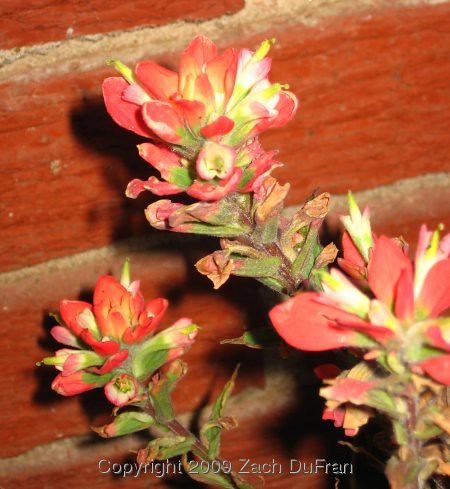The last two weekends my wife and I have been on the road across Oklahoma. April 18-19 we drove south into Texas, April 25-26 we drove east into Arkansas, and on May 2 we drove north to Stillwater, Oklahoma. We have seen lots of color along the road. On our trip down to Fort Worth, Texas, we saw Indian Paintbrush (Castilleja sp.), Texas Bluebonnet (Lupinus texensis), Indian Blanket (Gaillardia pulchella) and some light pink cup-shaped blooms called Light Poppy-mallow (Callirhoe alcaeoides). On our drive to Siloam Springs, Arkansas, we saw more Indian Paintbrush (Castilleja sp.), Crimson Clover (Trifolium incarnatum), purple Texas Toadflax (Nuttallanthus texanus), purple Verbena (Verbena canadensis), purple Blue-Eyed Grass (Sisyrinchium sp.), and some tiny flowering Daffodils (Narcissus sp.).
 |
| Verbena canadensis with Blue-Eyed Grass (Sisyrinchium sp.) in the foreground lower left. |
 |
| Tall plant with purple blooms is Nuttallanthus texanus. Crimson Clover (Trifolium incarnatum) is in the foreground lower left. |
 |
| Field of Crimson Clover (Trifolium incarnatum) in eastern Oklahoma. This was our favorite wildflower seen on our roadtrips. |
The Indian Blanket (Gaillardia pulchella) that we saw in the southern part of the state is Oklahoma's state wildflower. In some states, one flower would be enough official representation, but not here. Oklahoma is represented by three different flowers. Mistletoe (Phoradendron serotinum) is the state "floral emblem," adopted 14 years before Oklahoma became a state. The state wildflower was adopted in 1910, three years after Oklahoma became a state. And the official state flower is the hybrid Tea Rose named "Oklahoma." It was not added until 2004! While the rose is crimson in color (one of the University of Oklahoma's two school colors), the hybrid was bred at a rival school, Oklahoma State University.
 |
| Texas Bluebonnets - state flower of Texas |
I think the rose was adopted as the state flower due to all of the jokes going around about Oklahoma's flower actually being a parasite. Even with the high standing of mistletoe around the Christmas season, the parasitic label wasn't something the state wanted perpetuated. So the mistletoe got demoted to "floral emblem." I think that's kind of funny. I would almost prefer the rose to be our "floral emblem," considering it has an attractive flower. No one really pays attention to the flowers of Mistletoe. Maybe it should be our "berry emblem."
There was a small amount of protest when the bill was introduced to adopt the rose as the state flower, since it is not native to Oklahoma. Ultimately, there were many more people who were happy to borrow a non-native as our flower and lay the mistletoe aside. Many gardening groups and nurseries across the state were strong supporters of the hybrid rose. [Here's the
story.]
 |
| Indian Paintbrush (Castilleja indivisa). This is another of our favorites and the most plentiful wildflower in Oklahoma. |
Personally, I would have been in favor of promoting the Indian Blanket to the state flower. Either that, or adopting the Indian
Paintbrush (pictured above) as the state flower. According to the
USDA Plants Profiles webpage, there are four species of Indian Paintbrush that grow natively in Oklahoma (scarlet Indian Paintbrush
C. coccinea, downy Indian Paintbrush
C. purpurea, downy painted cup
C. sessiliflora, entireleaf Indian Paintbrush
C. indivisa). The Indian Paintbrush species C. linariaefolia is designated as the state flower of Wyoming. The flowers that I see on the side of the road in Oklahoma are salmon colored, most likely
C. indivisa.
Coincidentally, the Indian Paintbrush is also a parasite! I must admit that I am not very knowledgeable about parasites, but I think the Indian Paintbrush is sort of an unusual parasite. The parasites I am familiar with are those like the Mistletoe, which are obviously living off of a host plant. The Indian Paintbrush, on the other hand, secretly feeds off of nearby plants by tapping into the roots. Various grasses usually serve this purpose, but the Oklahoma Gardening Guide suggests planting Indian Paintbrush with Bluebonnets. I'm not sure if Steve Dobbs made the suggestion tongue-in-cheek, delighted by the idea that a symbol of Oklahoma would be sucking life out of a symbol of Texas, or if I was just reading too much into it. :)





I live in Oklahoma and would love to find the field of crimson clover above. Can you please tell me where this is located in eastern oklahoma via email?
ReplyDelete